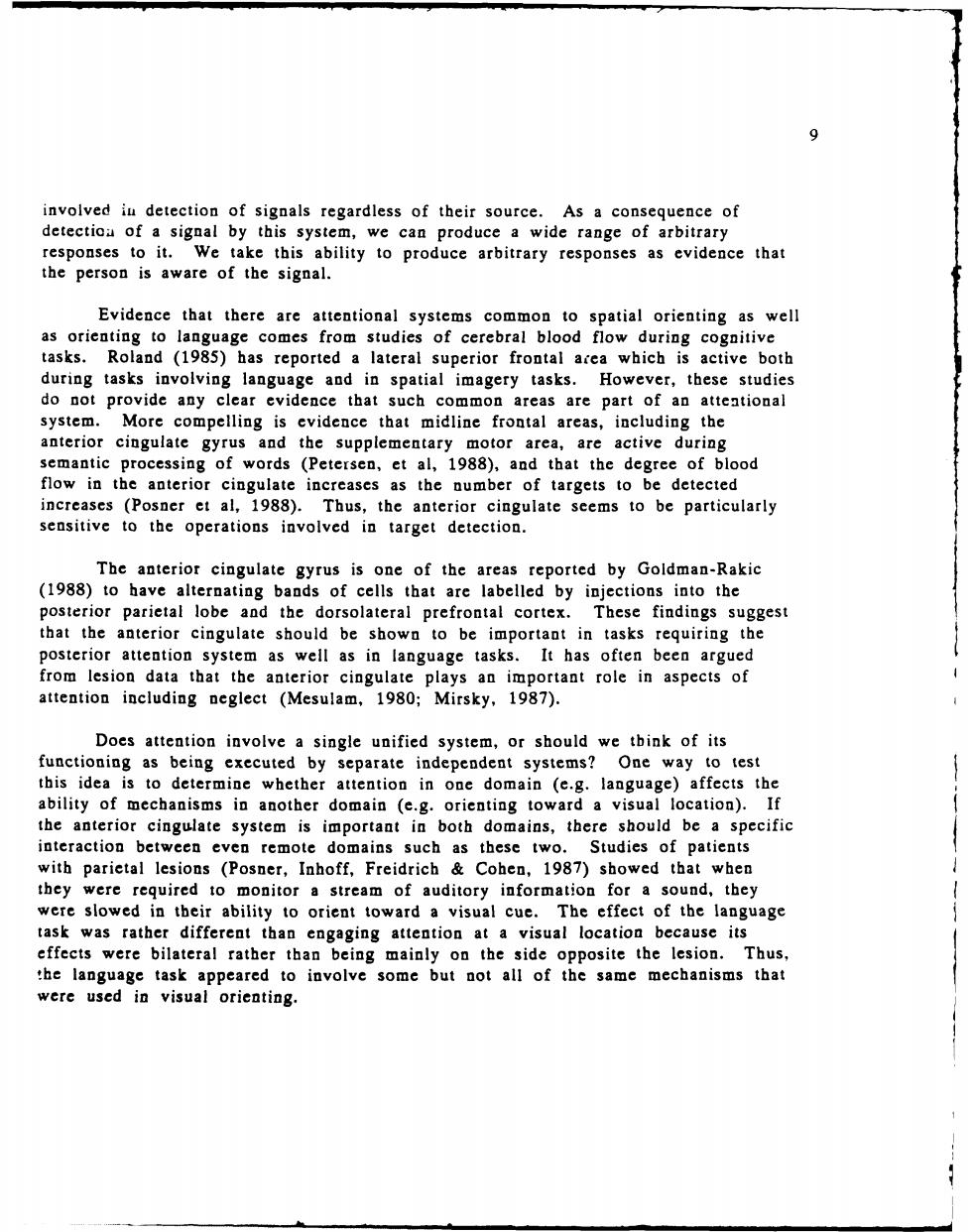正在加载图片...

involved iu detection of signals regardless of their source.As a consequence of detectiou of a signal by this system,we can produce a wide range of arbitrary responses to it.We take this ability to produce arbitrary responses as evidence that the person is aware of the signal. Evidence that there are attentional systems common to spatial orienting as well as orienting to language comes from studies of cerebral blood flow during cognitive tasks.Roland (1985)has reported a lateral superior frontal acea which is active both during tasks involving language and in spatial imagery tasks.However,these studies do not provide any clear evidence that such common areas are part of an atteational system.More compelling is evidence that midline frontal areas,including the anterior cingulate gyrus and the supplementary motor area,are active during semantic processing of words (Petersen,et al,1988),and that the degree of blood flow in the anterior cingulate increases as the number of targets to be detected increases (Posner et al,1988).Thus,the anterior cingulate seems to be particularly sensitive to the operations involved in target detection. The anterior cingulate gyrus is one of the areas reported by Goldman-Rakic (1988)to have alternating bands of cells that are labelled by injections into the posterior parietal lobe and the dorsolateral prefrontal cortex.These findings suggest that the anterior cingulate should be shown to be important in tasks requiring the posterior attention system as well as in language tasks.It has often been argued from lesion data that the anterior cing rs an important role in aspects of attention including neglect (Mesulam 1980: Mirsky,1987). Does attention involve a single unified syst or should we tbink of its functioning y to test this idea ted by separ epe af ability (c.Ba ion) the 0 io 4 b spe cific par es (Posner, 081 6 e) e90 auditory informa s they ab orient owa cue the language was rathe differen tha engaging attention a ual locat were bilateral rather than being mainly on the side opposite the language task appeared to involve some but not all of the same mechanisms that were used in visual orienting. 9 involved in detection of signals regardless of their source. As a consequence of detection of a signal by this system, we can produce a wide range of arbitrary responses to it. We take this ability to produce arbitrary responses as evidence that the person is aware of the signal. Evidence that there are attentional systems common to spatial orienting as well as orienting to language comes from studies of cerebral blood flow during cognitive tasks. Roland (1985) has reported a lateral superior frontal area which is active both during tasks involving language and in spatial imagery tasks. However, these studies do not provide any clear evidence that such common areas are part of an attentional system. More compelling is evidence that midline frontal areas, including the anterior cingulate gyrus and the supplementary motor area, are active during semantic processing of words (Petersen, et al, 1988), and that the degree of blood flow in the anterior cingulate increases as the number of targets to be detected increases (Posner et al, 1988). Thus, the anterior cingulate seems to be particularly sensitive to the operations involved in target detection. The anterior cingulate gyrus is one of the areas reported by Goldman-Rakic (1988) to have alternating bands of cells that are labelled by injections into the posterior parietal lobe and the dorsolateral prefrontal cortex. These findings suggest that the anterior cingulate should be shown to be important in tasks requiring the posterior attention system as well as in language tasks. It has often been argued from lesion data that the anterior cingulate plays an important role in aspects of attention including neglect (Mesulam, 1980; Mirsky, 1987). Does attention involve a single unified system, or should we think of its functioning as being executed by separate independent systems? One way to test this idea is to determine whether attention in one domain (e.g. language) affects the ability of mechanisms in another domain (e.g. orienting toward a visual location). If the anterior cingulate system is important in both domains, there should be a specific interaction between even remote domains such as these two. Studies of patients with parietal lesions (Posner, Inhoff, Freidrich & Cohen, 1987) showed that when they were required to monitor a stream of auditory information for a sound, they were slowed in their ability to orient toward a visual cue. The effect of the language task was rather different than engaging attention at a visual location because its effects were bilateral rather than being mainly on the side opposite the lesion. Thus, the language task appeared to involve some but not all of the same mechanisms that were used in visual orienting